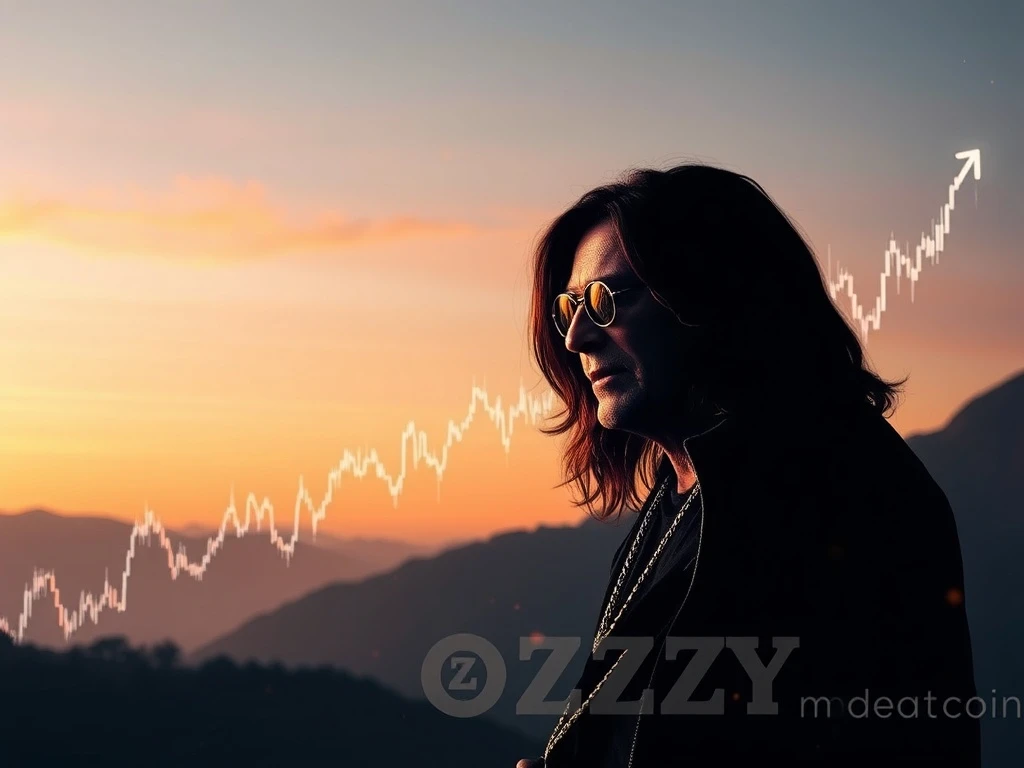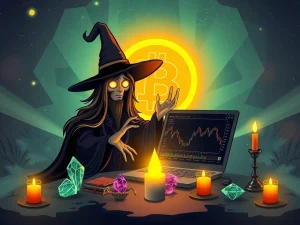Phenomenal OZZY Memecoin Surge: Ozzy Osbourne’s Legacy Ignites Crypto Market by 16800%

In a fascinating convergence of rock legend, digital assets, and an unexpected confession, the crypto world is abuzz. The recent passing of iconic musician Ozzy Osbourne has not only triggered a wave of heartfelt tributes but also sparked an incredible surge in a specific digital token: the OZZY memecoin. This dramatic market movement highlights the powerful, often unpredictable, link between cultural moments and cryptocurrency valuations. But the story doesn’t end there. Adding another layer of intrigue, Ripple’s Chief Technology Officer, David Schwartz, has recently revealed a decade-old incident involving his interaction with Osbourne, shedding light on the complexities of early digital fan engagements.
The Explosive Rise of OZZY Memecoin: A Legacy Token’s Moment
The cryptocurrency market, known for its volatility and rapid shifts, recently witnessed an astonishing event. Following the news of rock legend Ozzy Osbourne’s passing, a tribute token named The Mad Man (OZZY) experienced an extraordinary price increase. This OZZY memecoin skyrocketed by over 16,800%, reaching a peak of $0.003851 and pushing its market capitalization to $3.85 million. This sudden spike underscores how deeply cultural events and collective sentiment can influence the value of digital assets, particularly those designed as fan tributes or novelty tokens.
What drives such a significant memecoin surge? Several factors often play a role:
- Tribute and Commemoration: Fans and investors often rally around tokens associated with beloved figures as a way to pay homage and keep their legacy alive.
- Community Hype: Social media and crypto communities quickly amplify news, drawing more attention and new participants to the token.
- Speculative Trading: The potential for rapid gains attracts traders looking to capitalize on short-term price movements.
The OZZY token’s performance serves as a potent example of how cultural moments can create unique market dynamics, turning a digital tribute into a high-performing asset, at least for a period.
Ozzy Osbourne’s Enduring Influence and Crypto Connection
Ozzy Osbourne, often hailed as the “Prince of Darkness,” left an indelible mark on music and pop culture. His recent passing at 76 years old prompted a global outpouring of grief and appreciation for his groundbreaking career with Black Sabbath and his successful solo ventures. It’s this profound cultural impact that directly fueled the OZZY memecoin‘s rise.
While not directly involved in cryptocurrency during his lifetime, Osbourne’s enduring popularity and rebellious spirit have resonated with the decentralized ethos often associated with crypto. His name and persona have become a symbol that communities can rally around, even in the digital realm. This phenomenon highlights a growing trend where the cultural capital of celebrities and iconic figures transcends traditional media, finding new expressions and value in the blockchain space. The market’s reaction to his passing wasn’t just about a token; it was about the collective desire to honor a legend, and for some, to participate in a unique form of digital remembrance.
Ripple CTO’s Candid Confession: A Glimpse into Early Digital Interactions
Adding an unexpected layer to the story, David Schwartz, the Chief Technology Officer at Ripple, recently made a surprising confession that brought Ozzy Osbourne back into the spotlight from a different angle. Schwartz publicly acknowledged a decade-old incident where he falsified responses and censored profanity during a live Q&A session with Ozzy and Black Sabbath. This admission, shared on X, revealed a moment he now describes as a “failure of authenticity.”
During his time at WebMaster, a now-defunct tech company, Schwartz was tasked with facilitating a virtual event using their ConferenceRoom software. His role involved relaying fan questions and typing band members’ responses in real time. However, he encountered several challenges:
- Imbalanced Engagement: Most fan questions were directed solely at Osbourne, leaving other band members with little to say.
- Fabricated Responses: To ensure all band members participated, Schwartz resorted to using pre-written “canned questions” and blending their manager’s curated answers with what he could make out from the band.
- Censorship: Osbourne’s replies often contained profanity, specifically the “C-word,” which Schwartz admitted to censoring to align with corporate standards.
Schwartz’s confession provides a rare look behind the scenes of early digital celebrity engagements, revealing the ethical tightrope walked by intermediaries trying to balance authenticity with corporate protocols and technical limitations. While he aimed to ensure a balanced event, his actions highlight the tension between curated experiences and genuine interaction.
Understanding the Memecoin Surge Phenomenon: Beyond the Hype
The dramatic memecoin surge seen with the OZZY token is not an isolated incident. Memecoins, digital currencies often based on internet memes, pop culture references, or celebrity endorsements, have become a significant, albeit volatile, part of the crypto landscape. Their value is primarily driven by community sentiment, social media trends, and speculative trading rather than underlying utility or technological innovation.
Key characteristics of a typical memecoin surge:
- Community-Driven: Success heavily relies on a passionate and active online community that promotes the token.
- High Volatility: Prices can rise and fall dramatically within short periods, making them high-risk, high-reward investments.
- Celebrity/Cultural Association: Tokens linked to famous personalities or trending cultural phenomena often gain traction quickly.
While the OZZY token’s surge was fueled by a somber occasion, it demonstrates the powerful emotional and psychological triggers that can drive market movements in the memecoin space. Investors and enthusiasts alike often see these tokens as a way to participate in a cultural moment or express fandom, even if the financial fundamentals are less clear.
What Does This Mean for Crypto Legacy?
The concept of a “crypto legacy” is emerging as digital assets become more intertwined with culture and personal branding. For figures like Ozzy Osbourne, whose influence spans decades, the creation and surge of a tribute token like OZZY demonstrate how an artist’s impact can extend into new, decentralized forms of value. This isn’t just about financial speculation; it’s about how digital communities choose to memorialize, celebrate, and interact with the enduring influence of public figures.
The incident involving the Ripple CTO, David Schwartz, also adds to this narrative by highlighting the evolving standards of transparency and authenticity in digital interactions. As technology advances, the line between curated experiences and genuine connection becomes increasingly blurred. Schwartz’s retrospective regret underscores the importance of integrity, even in seemingly minor digital interactions, and how past actions can resurface to influence perceptions, particularly for figures in prominent tech roles.
Ultimately, the story of the OZZY memecoin surge, coupled with the Ripple CTO‘s confession, paints a vivid picture of the multifaceted nature of the crypto world. It’s a space where cultural moments intersect with technological developments, where speculative gains meet ethical dilemmas, and where the legacies of icons find new, unexpected forms of expression.
Conclusion: A Symphony of Culture, Code, and Confession
The recent events surrounding the OZZY memecoin, the passing of Ozzy Osbourne, and the candid admission from Ripple CTO David Schwartz offer a compelling narrative about the modern digital landscape. We’ve witnessed how a cultural icon’s passing can ignite a remarkable memecoin surge, demonstrating the potent influence of collective sentiment on digital asset valuations. Simultaneously, Schwartz’s reflection on his past actions highlights the ongoing quest for authenticity and transparency in our increasingly digital interactions, even those from a decade ago. This confluence of celebrity, technology, and market dynamics underscores the unique and often unpredictable nature of the crypto space, where a true crypto legacy can be forged not just through innovation, but also through cultural resonance and candid self-reflection. As the digital realm continues to evolve, so too will the ways we honor legends and navigate the complex ethical considerations of our connected world.
Frequently Asked Questions (FAQs)
What caused the OZZY memecoin to surge by 16,800%?
The OZZY memecoin surged dramatically following the news of rock legend Ozzy Osbourne’s passing. The surge was primarily driven by fans and investors paying homage to the late musician, leading to increased demand and speculative trading in the tribute token.
Who is David Schwartz and what was his confession about Ozzy Osbourne?
David Schwartz is the Chief Technology Officer (CTO) at Ripple. He recently confessed to an incident a decade ago where he falsified responses and censored profanity during a live virtual Q&A session with Ozzy Osbourne and Black Sabbath, describing it as a “failure of authenticity.”
Are memecoins like OZZY a good investment?
Memecoins are highly volatile and speculative investments. While they can offer significant short-term gains, as seen with the OZZY memecoin surge, they also carry substantial risks due to their reliance on community sentiment and lack of fundamental utility. Investors should exercise extreme caution and conduct thorough research.
How does a celebrity’s passing affect the crypto market?
The passing of a prominent celebrity can significantly impact crypto tokens associated with them, particularly memecoins. It often triggers a surge in demand as fans and speculators seek to commemorate the individual or capitalize on the increased attention, creating a temporary “tribute economy” within the digital asset space.
What are the ethical implications of the Ripple CTO’s past actions?
David Schwartz’s confession highlights the ethical dilemmas involved in mediating celebrity-fan interactions, particularly concerning authenticity and transparency. His actions, though framed as pragmatic solutions at the time, raise questions about the integrity of digital communication and the responsibility of those facilitating it, especially in high-profile contexts.









